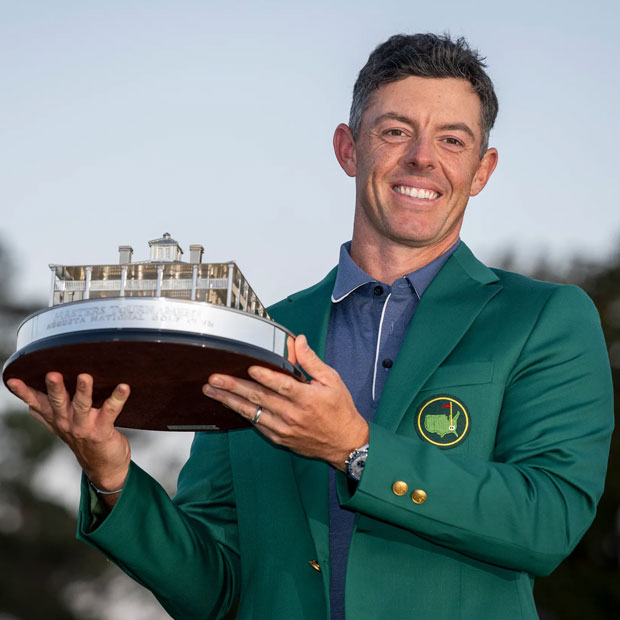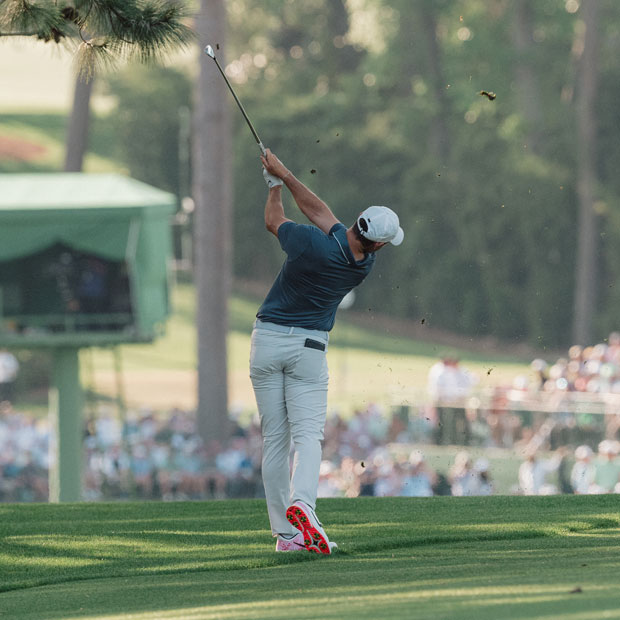Hoylake Memories
A personal history of a course that takes time to reveal itself


Prominently displayed on a wall in my office is a picture of “Punch Bowl,” the 11th hole (the members’ ninth) at Royal Liverpool Golf Club. It’s not really a picture, actually, but one of those incredible watermaps Joe McDonnell creates. You’ve probably seen them on Twitter or Instagram. As something of a luddite, I’ve not the faintest idea how the Englishman who works for the Clayton, DeVries & Pont design firm as “Head of Imagery” does them, but no matter. Just being able to look at it a few times a day and remember playing the hole so often in the distant past is what’s important.
The watermap shows the wonderful contours of the fairway, the dunes on either side, the diagonally set green in the punchbowl (hence the hole’s name) of sand hills that surround it, and the blue of the Dee Estuary to the left of the hole. (The estuary opens out into the Irish Sea beyond Hilbre Island with the north Wales coastline to the west, forming part of a beautiful panorama.)

Illustration by Joe McDonnell
Hoylake’s 11th is on my roulette wheel of favorite holes. Spin the wheel and the 17th on the Old Couse might come up, or the fifth at Royal St. George’s, second at Gamble Sands, fourth at Banff Springs, 10th at Kingston Heath, eighth at Pebble Beach, or any one of a dozen other holes that is definitely my absolute favorite, no ifs or buts… until I change my mind.
I’ll be forever grateful that I got to play “Punch Bowl” frequently as part of the Liverpool University golf team, which is fortunate to call Royal Liverpool its home course.
Despite losing plenty of games elsewhere, I don’t remember ever losing one at Hoylake, and I don’t recall ever being part of a losing team there. In the last match I played at RLGC, Liverpool took down the University of Manchester 6-0. No, the streets weren’t full of flag-waving fans firing pistols into the air, or cars honking their horns, but it was cause for a serious celebration.
Unlike some golf club/university team relationships, strained by memberships jealously guarding tee times or irritated by a group of students playing their course for free and then taking up precious space in the bar, Royal Liverpool could not have been more accommodating or welcoming. Once all the formal activity was completed and our opponents had left, we’d often be joined for a drink by members asking how the match went.
“It is a royal club, obviously,” says Mike Harris, a 15-year member and himself a former Liverpool University player, “but it’s the ultimate non-royal club, if you know what I mean.” Of course, there’s a little pomp and circumstance, Harris adds, but Royal Liverpool doesn’t take itself too seriously and is really all about the game. “There are a lot of prominent people from various walks of life here,” Harris notes, “but whether they’re a surgeon, professor, or successful businessman/woman, all anyone wants to do when they arrive is talk about golf.”
Harris talks a lot about golf both at the club and at his job. As the editor of popular British magazine Golf Monthly for the last 17 years, he has been in a position to play a number of the world’s best courses. And while a few of them may appear higher than Royal Liverpool in most course rankings—it’s currently 12th in Great Britain and Ireland in his own publication—he rarely feels happier than when taking on the much-evolved links, whose original nine holes were laid out on the same land as the Liverpool Hunt Club’s racecourse and which this week is hosting its 13th Open Championship.
He played it for the first time somewhen in the late 1980s, when a university team member came down with a dreadful hangover and Harris was called into the breach at the last moment. “We were playing Keele University and I remember winning on the 14th,” he says.
The members’ 14th (Open 16th) is one of Hoylake’s 10 or so holes that, because it covers mainly flat ground, isn’t given much love but which, on closer examination and after several plays, you discover is actually a very fine hole requiring superlative ball-striking but also careful management if its challenge is to be met. Harris says the course really allows golfers to use their imaginations and play a variety of shots. “More often than not, though,” he says. “it really helps to be able to keep the ball low.”
The club’s motto—“Far and Sure”—is undeniably fitting, though Harris believes that while “far” is certainly useful, the “sure” part is actually more important at Hoylake. That’s certainly true of his favorite hole, the short 13th (members’ 11th) in the dunes overlooking the Dee and one of Harry Colt’s finest contributions to the course when he worked here in the mid-1920s. “I just love the hole,” says Harris. “I must have played it 200 times, but I get my phone out and take a picture every single time I stand on that tee.”

Royal Liverpool's 13th hole, "Alps." Photo credit: Sam Cooper
While the prevailing wind comes from the left here, it is firmly in your face on what is perhaps Hoylake’s best-known hole, the 426-yard third (members’ first), where a high degree of “sure” is required to avoid the internal out-of-bounds on the right with your drive and approach shot. It doesn’t take much imagination, or experience, to sense how nervous members must be when they stand up to the ball for their opening tee shot. And even though Open competitors have had two holes to warm up by the time they reach it and really only need a long iron and mid- or short iron to reach the green, the sight of the cop (mound) marking the edge of the club’s practice ground, which is OB, will probably still raise their anxiety.
“I always tell myself not to par the first,” Harris says. “If I make a par there, I inevitably start feeling cocky and think that a good round is on the cards, which is very dangerous thinking for a 10-handicapper, of course.”
One person who certainly didn’t follow Harris’s recommendation was American Tim Gallant, who now lives and works in Scotland and who actually walked off the first green during his one and only round at Hoylake with a two. “I was playing with three members and hit a pretty decent drive considering how nervous I was,” he says. “I thinned my second with a 6-iron, but watched as it pitched well short of the green, bounced on and went in the hole.” One of the longtime members in the group told Gallant that he’d never heard of anyone eagling the first before. “I don’t know if that’s true or not,” he says, “but I imagine it’s a rarer feat than an ace on any of the par 3s given how difficult the hole is.”

The third hole (bottom)—members' first—at Royal Liverpool. Photo credit: Sam Cooper
Dan Davies, another Liverpool University golf team alumnus, certainly never made any twos on No. 1 and remembers often feeling a little nauseous on the tee. “It’s such a scary hole,” he says “especially when it’s cold, wet, and windy which it was a lot in the autumn when the university played its matches.”
Davies, now the Head of Content at AI golf performance platform Clippd, says his fondest memory of Hoylake might be the evening he chipped along the clubhouse landing and up the staircase under the portrait of Bobby Jones (who played his first and last rounds in Britain at Hoylake and won the Open Championship here in 1930—the year of his “Impregnable Quadrilateral”) during one university alumni golf day.
“It’s a really great club and I love its history, traditions, and welcome,” Davies says, “even if the course is guaranteed to beat me up every time.”
It’s remarkable, really, how the course reflects the city of Liverpool itself—back over the River Mersey 13 miles to the east. It’s tough, stark, even a little dour in places, but deep down the people you find there are hospitable and have a wicked sense of humor. “Liverpudlians are a breed apart really,” says Mike Harris, “but in the nicest possible way. It’s true of a lot of cities around the world, but if you’ve never been to Liverpool you just won’t understand the mentality, the vibe, at first.”
Doubtless a lot of competitors at this year’s Open Championship, gallery members, and TV viewers won’t understand Royal Liverpool’s appeal at first either. They’ll think it bland and perhaps a little flavorless. Spend four days playing or watching it, however, and that opinion will change. As Bernard Darwin once described it, Hoylake is a “breeder of mighty champions” and is most definitely worthy of golf’s oldest major.
Tony Dear (@tonyjdear) has contributed to Links Magazine, Colorado Avid Golfer, and Cascade Golfer, among other publications. He is the author of The Story of Golf in 50 Holes.
The photos featured in the header and body of this article were taken by Sam Cooper (@sd_cooper), an associate golf architect with Clayton, DeVries & Pont.
Leave a comment or start a discussion
Engage in our content with thousands of other Fried Egg Golf Club Members
Engage in our content with thousands of other Fried Egg Golf Members
Get full access to exclusive benefits from Fried Egg Golf
- Member-only content
- Community discussions forums
- Member-only experiences and early access to events











Leave a comment or start a discussion
Lorem ipsum dolor sit amet, consectetur adipiscing elit. Suspendisse varius enim in eros elementum tristique. Duis cursus, mi quis viverra ornare, eros dolor interdum nulla, ut commodo diam libero vitae erat. Aenean faucibus nibh et justo cursus id rutrum lorem imperdiet. Nunc ut sem vitae risus tristique posuere. uis cursus, mi quis viverra ornare, eros dolor interdum nulla, ut commodo diam libero vitae erat. Aenean faucibus nibh et justo cursus id rutrum lorem imperdiet. Nunc ut sem vitae risus tristique posuere.